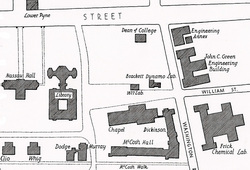From the start of the Depression until the end of World War II, construction activity at Princeton, like at other universities, was at a near standstill. The first buildings to be erected here as part of the post-war building boom on American campuses were the Dillon Gym and the Harvey S. Firestone Memorial Library. The four silent films discussed on this post, which are all in color, capture the beginning of the construction of Firestone Library, the dedication of the Dillon Gym in June 1947, and other activities at the close of the bicentennial celebrations of 1946-1947 and the immediate years thereafter.
 As can be seen on this campus map, the space between Washington Road and the then library (what is now Chancellor Green and Pyne Hall) was quite open. During most of the film the camera is facing the Engineering Building on Washington Road (now Burr and Green Hall), and moves between the Joseph Henry House, home of the Dean of the College (the white house seen on the left) and the ’77 Laboratory (the square brick building with the crescent shaped windows on the right). This biology laboratory, donated by the Class of 1877 at its tenth reunion, was demolished in the summer of 1946, which is captured starting at 9:15. The ’77 Lab appears as a pile of rubble at 9:21, when the Bracket Dynamo Laboratory behind it becomes visible. This second lab is gradually broken down in the footage that follows.
As can be seen on this campus map, the space between Washington Road and the then library (what is now Chancellor Green and Pyne Hall) was quite open. During most of the film the camera is facing the Engineering Building on Washington Road (now Burr and Green Hall), and moves between the Joseph Henry House, home of the Dean of the College (the white house seen on the left) and the ’77 Laboratory (the square brick building with the crescent shaped windows on the right). This biology laboratory, donated by the Class of 1877 at its tenth reunion, was demolished in the summer of 1946, which is captured starting at 9:15. The ’77 Lab appears as a pile of rubble at 9:21, when the Bracket Dynamo Laboratory behind it becomes visible. This second lab is gradually broken down in the footage that follows.
Only the last few minutes of the film (10:39-14.15), capture the beginning of the construction of the Firestone Library itself, starting with the lowest floor. The snow at 11.31, surrounding the concrete columns, indicates that a year has passed since the time lapse filming began. On January 15, 1947 the Prince wrote that most of the underground structure had been completed. The footage at 11.53, which includes a view on Nassau Street, must have been filmed during or shortly after February 1947, when the library, according to the Prince had risen above the ground. The film ends with footage of the building of the steel structure of the library’s three floors (13:11), the last shots of which indicating that it is springtime now (13:32).
The second film was shot by Lawrence L. Rauch *49, a graduate at the Department of Mathematics, during the reunion weekend of June 14-17, 1947, which marked the conclusion of Princeton’s year-long bicentennial celebrations. The film opens with the dedication of the Dillon Gym on Saturday June 14, prior to the P-rade. The gymnasium, named after the principal donor, onetime football captain Herbert Dillon ’07, had been a first priority after the old gymnasium, built in 1903 and located at the same spot, was destroyed by a fire on May 13, 1944.
After some P-rade footage (1:48) the film continues at 3:34 with the laying of the cornerstone of the Harvey S. Firestone Memorial Library on Monday morning, June 16, by the widow of rubber tire manufacturer Harvey Firestone, in whose honor the library was named. A description of the ceremony can be found in the Daily Princetonian of June 9, a copy of which went into the time capsule inside the cornerstone. President Harold Dodds poses with the five sons of Harvey Firestone, all Princeton alumni, at 4:10. The library is still mainly the steel structure that was seen at end of the previous film.
The footage is followed at 7:10 by the Bicentennial Convocation procession on Tuesday morning June 17, the closing ceremony of the Bicentennial Year, during which many distinguished guests received an honorary degree, including US President Harry Truman. This convocation is also featured in the Paramount newsreel, discussed in our previous blog. Rauch filmed some of the most famous notables in the procession up close, including Dwight D. Eisenhower (6:53 and 9:20), Albert Einstein (7:01 and 9:12), Herbert Hoover (7:01), Harry S. Truman (7:13 and 9:04) and Admiral Chester Nimitz (9:17).
The third film, also shot by Lawrence Rauch *49, contains miscellaneous Princeton and personal scenes. After spring scenes on campus the footage continues with aerial views of Princeton and New York (2:55), possibly related to work Rauch was involved in outside his graduate research. The footage from 4:14 captures various campus scenes, including an unidentified football game (4:52). The footage of this film was found with Rauch’s recording of the move of Corwin Hall in 1963, discussed in a previous blog.
The fourth film, which seems to have been shot by a member of the prominently featured Class of 1929, contains additional footage of the P-rade and other scenes of the reunion weekend at the end of the Bicentennial year, including the Yale baseball match (with Present Harold Dodds and his wife, 4:53), and outdoor dining scenes (5:35).
